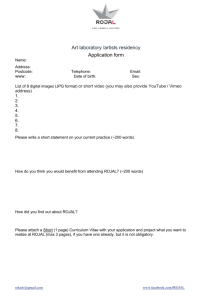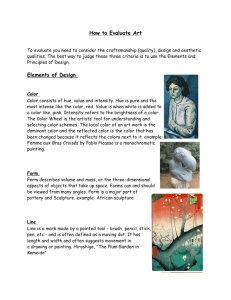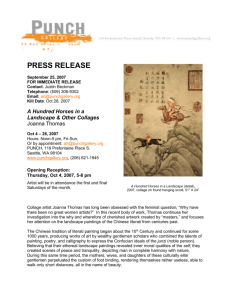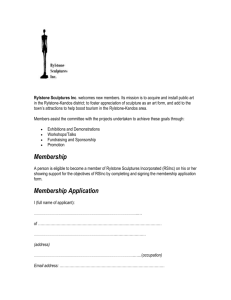Human Being 2008 - Meg Walker Sculptor
advertisement
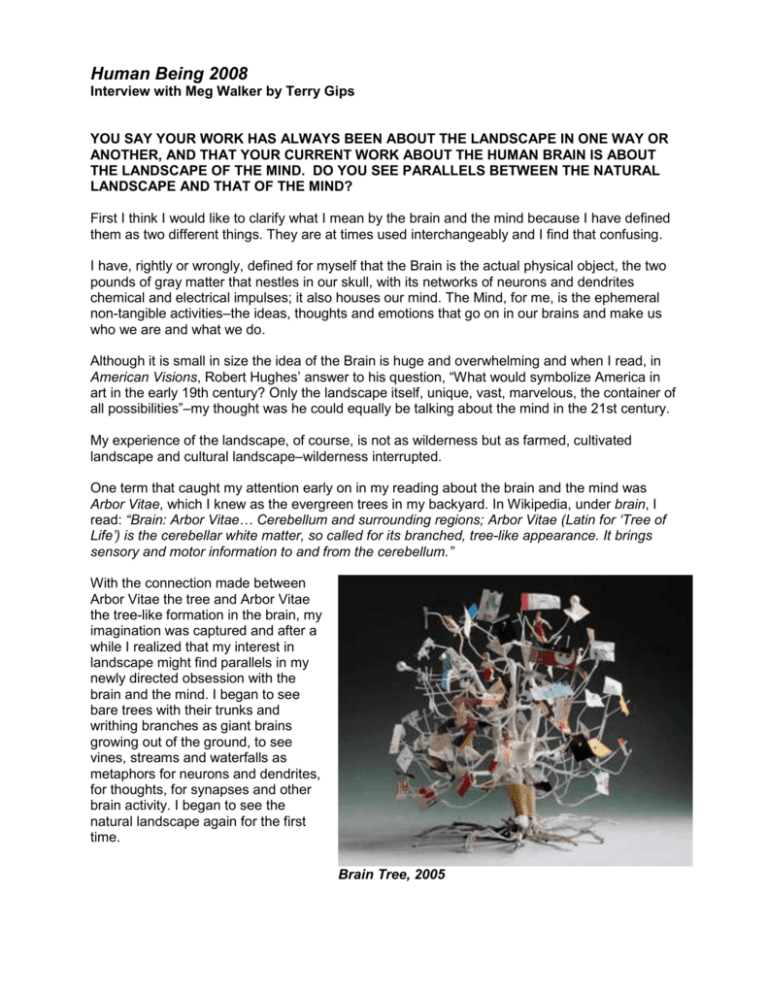
Human Being 2008 Interview with Meg Walker by Terry Gips YOU SAY YOUR WORK HAS ALWAYS BEEN ABOUT THE LANDSCAPE IN ONE WAY OR ANOTHER, AND THAT YOUR CURRENT WORK ABOUT THE HUMAN BRAIN IS ABOUT THE LANDSCAPE OF THE MIND. DO YOU SEE PARALLELS BETWEEN THE NATURAL LANDSCAPE AND THAT OF THE MIND? First I think I would like to clarify what I mean by the brain and the mind because I have defined them as two different things. They are at times used interchangeably and I find that confusing. I have, rightly or wrongly, defined for myself that the Brain is the actual physical object, the two pounds of gray matter that nestles in our skull, with its networks of neurons and dendrites chemical and electrical impulses; it also houses our mind. The Mind, for me, is the ephemeral non-tangible activities–the ideas, thoughts and emotions that go on in our brains and make us who we are and what we do. Although it is small in size the idea of the Brain is huge and overwhelming and when I read, in American Visions, Robert Hughes’ answer to his question, “What would symbolize America in art in the early 19th century? Only the landscape itself, unique, vast, marvelous, the container of all possibilities”–my thought was he could equally be talking about the mind in the 21st century. My experience of the landscape, of course, is not as wilderness but as farmed, cultivated landscape and cultural landscape–wilderness interrupted. One term that caught my attention early on in my reading about the brain and the mind was Arbor Vitae, which I knew as the evergreen trees in my backyard. In Wikipedia, under brain, I read: “Brain: Arbor Vitae… Cerebellum and surrounding regions; Arbor Vitae (Latin for ‘Tree of Life’) is the cerebellar white matter, so called for its branched, tree-like appearance. It brings sensory and motor information to and from the cerebellum.” With the connection made between Arbor Vitae the tree and Arbor Vitae the tree-like formation in the brain, my imagination was captured and after a while I realized that my interest in landscape might find parallels in my newly directed obsession with the brain and the mind. I began to see bare trees with their trunks and writhing branches as giant brains growing out of the ground, to see vines, streams and waterfalls as metaphors for neurons and dendrites, for thoughts, for synapses and other brain activity. I began to see the natural landscape again for the first time. Brain Tree, 2005 DID YOU MAKE A CONSCIOUS DECISION TO SHIFT THE FOCUS OF YOUR ART TO THE BRAIN AND THE MIND? AND DO YOU IDENTIFY ANY WORKS AS SPECIFICALLY TRANSITIONAL? Yes, I did make a conscious decision. My habit is to name what I am going to do before I start making things; but before I even get to that naming part, there seems to be a long gestation period and I am talking years. I have always been interested and loved the process I go through in making sculptures and drawings and I feel that the idea or initial concept is really central, really core to my work. So although the work had been about the world outside my head, the process going on in my brain always fascinated me. I am very slow in my production habits and tend to work on an idea for a few years before I am finished with it. I work in series; there needs to be a certain obsessive quality in what I am thinking about and looking at for me to get started. Prior to the Brain/Mind pieces, which I started in 1997, I had been making sculptures and drawings about Scottish and American farm barns; before that it was about Birds. I like the concept of focusing, of exploring an idea in a deeper way and then when I am done with it moving on to something else that has captured my imagination. I do remember being in my studio one day, probably 1996, and thinking, “I am going to work on the Brain next,” and that was the start of it. I must have been building up an awareness through reading articles in magazines and newspapers about what was happening in neuroscience. The first pieces that I made were a group of little ceramic head sculptures, some of which are in What Were They Thinking? I had been reading Charles Darwin’s book, The Expression of Emotion in Man and Animals, and that idea was something that I could understand. They, along with some small tree-like brain-like watercolors, were the first and so can be thought of as transitional but really I had been thinking and reading and looking for a while before I started to make things. What Were They Thinking?, 2005 When I recognized the hugeness of what I had gotten myself into, I had to make some small things to get started, to move beyond being overwhelmed and paralyzed. My work process is a constructional one; I build things and that goes for my mental process as well as the physical one. THE BODY OF WORK THAT DIRECTLY PRECEDES YOUR WORK ON THE BRAIN DEALT WITH BARNS, RIGHT? SOME OF THOSE SCULPTURES ARE VERY FANCIFUL AND, TO ME, SUGGEST SOME OF THE WAYS I THINK ABOUT THE SPACE OR ARCHITECTURE OF THE BRAIN AND THE MIND, WHICH DOESN’T SEEM TO BE TIED DOWN TO A RIGID OR FIXED FOUNDATION. DO YOU SEE ANY CONNECTIONS BETWEEN THE BARNS AND YOUR CURRENT WORK? That is an interesting question. I am not sure; my process of obsessing, naming, researching and making, applies to whatever I am working on. The barns were based on real barns in the landscape that I had made drawings of or photographed. As I was not interested in simply making architectural models of what I had seen, I began to play with the forms, stacking them or setting them off balance. I was not particularly interested in the interior space of the barns, I liked looking through them. They may be thought of as fanciful but for me I was answering the question “what could I do with these forms given that I was not constrained by the reality of building? And besides being interesting to look at, do they mean anything else in a metaphorical way? When I think about the architecture of the brain, my image is much grander– it is of the 18th century prints of Piranesi—imaginative drawings of Roman prisons or of the interior of the Duomo (Cathedral) in Sienna; it is all about interiors, high spaces and intimate nooks and crannies. In many ways, I think of my studio, which is two stories high, as being like the interior of my brain. It is full of references to years of work, some order, some chaos and a lot of cobwebs. For this exhibition, Human Being, I am trying to create a space that is a bit like that, like walking into a working brain. It is not based on any kind of reality but is rather a construct of my imagination. WHAT MATERIALS DO YOU USE FOR YOUR WORK ON THE BRAIN? I use fairly humble, often recycled materials in my sculptures. I am also interested in taking already existing consumer products and, by altering them slightly or placing them in a new context, transforming or changing how they are perceived. Further, this recent work is leading me down new paths, I am using electrical lighting. I frequently read that with MRI machines scientists can identify what is going on in our heads and they use electrical terms to describe what they see; for example, different parts of the brain lighting up or electrical impulses happening. It seemed like a natural progression to use electrical lights in some of these new pieces; using them in the way that we use light references when we talk about what goes on in our head— the light bulb coming on, shedding light on the matter, synapses firing, and so on. As a non-techie person, it is a challenge that has lead me to working with lighting and electrical engineers and I am finding myself in a whole new, very interesting, world. Bouquet, 2008 SOME OF YOUR NEWEST PIECES NOT ONLY INCLUDE ELECTRICAL ELEMENTS, BUT THEY ARE ALSO INTERACTIVE. THIS SUGGESTS TO ME THAT YOU FEEL THAT STATIC IMAGES OR FORMS DON’T QUITE HIT THE MARK ON THE SUBJECT OF THE BRAIN AND THE MIND. CAN YOU TALK A LITTLE ABOUT WHAT ROLE INTERACTIVITY PLAYS IN THESE SCULPTURES? You are right, this work is about the activities that go on in our heads as human beings. I want the pieces to reflect that sense of actions taking place, of work going on. All art requires the viewer to complete it; the electrical pieces acknowledge that when the viewer crosses their sensors by lighting up and starting their performances. The pieces are interactive in a very limited way - they are on motion sensors, which start the programmed sequence of lights in the individual sculptures. By walking within the sensor's gaze, the viewer initiates the light sequence but has no control over how it plays out. The lights acknowledge a presence, as we humans mentally acknowledge another's presence in the room. I have also begun to explore the way we process language and reading in our brains. The piece "UNRAVELED" does include a verse of a poem that requires the reader to unravel the jumbled letters. The other practical side of course is to conserve electricity when no one is around. WHAT YOU ARE TRYING TO FIND OUT ABOUT THE BRAIN? It has taken me a long time to figure it out but I believe that what I am trying to find out is how to make visible, through my sculptures and drawings, what goes on in our minds as human beings. I don’t see scientists ever being able to do this; it will always be up to the artists, dancers, poets, writers, and musicians to express what happens in our mind’s eye. WHY ARE YOU AND SO MANY OTHER ARTISTS INTERESTED IN SCIENCE? Like many movements in art history, it is in the air. At this time, it seems to me that art is not where the most exciting, edgy and creative things are happening; it is in science and technology. Along with the Internet, there are lots of magazines, newspaper articles and film documentaries that give just enough nontechnical information to gain our attention, to spark our imagination and for some, that is all it takes. The world is changing rapidly and artists are always trying to get a handle on what this means. When I was in high school I had to have a special curriculum created for me because I wanted to take art and science. Artists and scientist did not work together. Also, although I have not met any, I know there are scientists and artists working together now. I am of an age where science and technology are not a comfortable situation, but I am curious and I see new art forms coming from those collaborations. Philtre, 2005 ALTHOUGH YOU ARE NOT ENGAGED IN A FORMAL COLLABORATION WITH A SCIENTIST, YOU DRAW ON THEIR RESEARCH AND SOME OF THEIR TECHNOLOGY. DO YOU THINK PEOPLE IN THE SCIENCES CAN TAKE SOMETHING AWAY FROM YOUR WORK THAT WOULD BE USEFUL TO THEM? I have no idea. I think a greater possibility is for a scientist to see my work, see that I am interested in what is going on in our heads and make a connection that possibly the way I see, think, act, live as an artist may be something she/he can use in their work. My work is based on the zillions of articles and bits of books I have read about the brain and mind and on my trying to make some sense of it plus using my imagination. The subject matter is completely new for me and the way that it seems to be manageable is if I connect it to my past work. This work, as we discussed earlier, comes out of the cultivated landscape and natural world in which I live. My work is not an attempt to illustrate what I have read about the brain, the mind and consciousness, but rather an attempt to make visible what has captured my imagination and understanding about it. Brain Unraveled: You Remain, 2008 THIS EXHIBITION OF YOUR WORK, SHOWN ALONG WITH THAT OF ANOTHER ARTIST FROM KIRKCUDBRIGHT, ALEX FLETT, HAS A RATHER OPEN-ENDED TITLE: HUMAN BEING. IT SEEMS YOUR INVESTIGATION OF THE HUMAN BRAIN IS AIMED AT UNDERSTANDING WHAT “BEING HUMAN” MEANS. SOME MIGHT ARGUE THAT ARTISTS HAVE BEEN DOING THAT FOR CENTURIES. ARE WE 21ST CENTURY HUMANS DIFFERENT FROM OUR PREDECESSORS, OR IS IT THAT THE PROCESS AND MEANS OF INVESTIGATING “BEING” AND CONSCIOUSNESS ARE DIFFERENT TODAY? I would not begin to claim that I am doing anything different from what "artists have been doing for centuries." We are all standing on the shoulders of the art movements and artists who have gone before us, hoping to make some contribution. There are differences though; our knowledge of the world has expanded and is expanding tremendously. I think that now, as human beings, we are more aware that we live in a global village, that what we do, how we think and act can affect not only ourselves but people in every part of the world. That affects the art that is being made. Further, there is a sense that in order to survive as a human race we must work together, collaborate, take responsibility. This "bigger picture" filters into the consciousness of artists. Historically, art movements happen and have happened when like-minded artists agree to work or show together. I think now, especially because of technology, there is a greater need to work collaboratively not only with other artists but also with professionals from other backgrounds. I could not have realized my most recent light sculptures without the assistance of an electrical engineer and other media technicians who could make the electrical components for my work and, equally importantly, who were open-minded enough to work with me when I often did not know what I was doing. I think that you make a really good point when you ask "is it that the process and means of investigating "Being" and consciousness are different today?" Through the advancements of science and technology we do have images—x rays and computer-aided models—available that just did not exist before and these have expanded our visual vocabulary and thinking. As scientists continue to study all living things, including human beings, they identify ways in which we are the same and how we differ. This is new information that artists can use. Also, as science allows us to integrate technology into our bodies in ways that previously only existed as science fiction—I am thinking here about cyborgs and intelligent computers—there is a greater interest in the question "What makes us human?" and artists will be exploring answers. Terry Gips is an artist, curator, and critic who lives and works on Cape Cod in Massachusetts. She began teaching digital imaging, using computers in her own work on memory, and writing about technology in the late 1980’s while on the faculty of the University of Maryland. She visits Scotland frequently and the focus of her major project of the last several years was the cloning of Dolly the sheep. Further information at www.coldmeadow.com.
